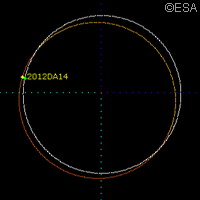Astronomers say small asteroid won't hit Earth in 2013
A newly identified asteroid will just miss hitting Earth in 2013, researchers say. Discovered by a group of astronomers in mid-February, the tiny 50-metre asteroid, called '2012 DA14', whizzed past our planet at about 7 times the distance of the Moon. Scientists at the European Space Agency (ESA) estimate that this asteroid will next fly by earth on 15 February 2013 at around 24 000 kilometres, which is closer than most commercial satellites. 'This is a safe distance, but it is still close enough to make the asteroid visible in normal binoculars,' says Dr Detlef Koschny, who oversees a team assessing near-earth objects in ESA's Space Situational Awareness (SSA) office. The La Sagra Sky Survey observatory in Spain identified the asteroid at an altitude of 1 700 metres, near Granada. Researchers say this area is one of the darkest and least light-polluted places in Europe. 'Considering its path in the morning sky, its rather fast angular motion, the quite faint and fading brightness and its orbit high above the plane of Earth's orbit, it was a slippery target - and easily could have escaped undetected during this Earth visit,' says Jaime Nomen, one of the discoverers at the La Sagra Sky Survey. Automated telescopes were used to scan the sky, and the asteroid was identified in areas where asteroids are not usually seen. 'A preliminary orbit calculation shows that 2012 DA14 has a very Earth-like orbit with a period of 366.24 days, just 1 more day than our terrestrial year, and it "jumps" inside and outside of the path of Earth 2 times per year,' Professor Nomen points out. Despite the fact that the asteroid will not hit Earth next year, astronomers plan to use this approach to perform more studies and shed fresh light on the Earth and the Moon's gravitational effects on the asteroid. 'We will also be keen to see the asteroid's resulting orbit after the next close approach in order to compute any future risk of impact,' Dr Koschny says. The Observatorio Astronomico de Mallorca runs the La Sagra Sky Survey, which recently joined the ESA's SSA programme. Experts say the Survey will provide observations to the asteroid data hub currently under development at ESA. Astronomers and policymakers use space weather and debris data to increase their understanding of and evaluate hazards. This is especially important when it comes to determining the dangers of approaching asteroids. With respect to the 2012 DA14 discovery, Dr Koschny says: 'We are developing a system of automated optical telescopes that can detect asteroids just like this one, with the goal of being able spot them at least three weeks before [the] closest approach to Earth.' ESA researchers are developing a network of 1-metre-diameter telescopes, which will give them the means to take images of the full sky in one night.For more information, please visit: ESA's Space Situational Awareness (SSA) office:http://www.esa.int/SPECIALS/SSA/index.html
Countries
Spain



